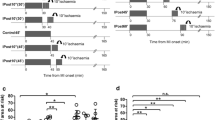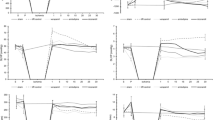Abstract
Ischemic injury is one of the most adverse pathogenic factors that evoke irreversible changes in organs and tissues. Cardioprotection from ischemia-reperfusion injury is an important challenge for modern experimental and clinical medicine. This type of injury is a key link in the pathogenesis of coronary heart disease and, above all, acute myocardial infarction, a socioeconomically significant disease that is one of the main causes of disability and mortality among the adult population. The aim of the study was to elucidate the infarct-size limiting effect of postconditioning (Post) with L-lactate during myocardial ischemia-reperfusion in young and old rats under atropine-induced blockade of M-cholinergic receptors. In experiments on rats, it was found that Post with L-lactate has an infarct-size limiting effect during myocardial ischemia-reperfusion in both young and old animals, however, under conditions of systemic atropine administration (2 mg/kg), this effect was persistent in old rats only. Apparently, the activity of the peripheral M-cholinergic systems is of importance for the implementation mechanisms of the cardioprotective effects of Post with L-lactate in young, but not old rats.


Similar content being viewed by others
REFERENCES
WHO reveals leading causes of death and disability worldwide 2000–2019. Available at: https://www.who.int/news/item/09-12-2020-who-reveals-leading-causes-of-death-and-disability-worldwide-2000-2019 (accessed 14.05.2022).
Shemarova IV, Nesterov VP, Korotkov SM, Silkin UA (2018) Evolutionary aspects of cardioprotection. J Evol Biochem Physiol 54(1): 9–19. https://doi.org/10.1134/S0022093018010027
Bautin AE, Karpova LI, Marichev AO, Tashkhanov DM, Naumenko VS, Galagudza MM (2016) Cardioprotective effects of ischemic conditioning: current concepts of mechanisms, experimental evidence, clinical implementation. Translat med 3(1): 50–62 https://doi.org/10.18705/2311-4495-2016-3-1-50-62
Maslov LN, Mrochek AG, Khaliulin IG, Hanus L, Pei JM, Zhang Y (2013) Adaptive phenomenon of ischemic postconditioning of the heart. Perspectives of clinical use. Ann Russ Acad Med Sci 68(1): 10–20 https://doi.org/10.15690/vramn.v68i1.532
Shlyakhto EV, Nifontov EM, Galagudza MM (2007) Limitation of ischemic and reperfusion injury of the myocardium using pre- and postconditioning: molecular mechanisms and targets for pharmacotherapy. Creative cardiol 1: 75–101. (In Russ).
Galagudza MM, Blokhin IO, Shmonin AA, Mischenko KA (2008) Reduction of myocardial ischaemia-reperfusion injury with pre- and postconditioning: molecular mechanisms and therapeutic targets. Cardiovascular & Hematological Disorders-Drug Targets 8(1): 47–65. https://doi.org/10.2174/187152908783884966
Zhao ZQ, Corvera JS, Halcos ME, Kerendi F, Wang NP, Guyton RA, Vinten-Johansen J (2003) Inhibition of myocardial injury by ischemic postconditioning during reperfusion: comparison with ischemic preconditioning. Am J Physiol—Heart Circulat Physiol 285: H579–H588. https://doi.org/10.1152/ajpheart.01064.2002
Basalay M, Barsukevich V, Mastitskaya S, Mrochek A, Pernow J, Sjöquist PO, Ackland GL, Gourine AV, Gourine A (2012) Remote ischaemic pre- and delayed postconditioning—similar degree of cardioprotection but distinct mechanisms. Experiment Physiol 97(8): 908–917. https://doi.org/10.1113/expphysiol.2012.064923
Ferdinandy P, Hausenloy DJ, Heusch G, Baxter GF, Schulz R (2014) Interaction of risk factors, comorbidities, and comedications with I-R injury and cardioprotection by preconditioning, postconditioning, and remote conditioning. Pharmacolog Rev 66(4): 1142–1174. https://doi.org/10.1124/pr.113.008300
Heusch G (2015) Molecular basis of cardioprotection: signal transduction in ischemic pre, post, and remote conditioning. Circulat Res 116:674–699. https://doi.org/10.1161/CIRCRESAHA.116.305348
Naryzhnaya NV, Logvinov SV, Kurbatov BK, Mukhomedzyanov AV, Sirotina MA, Chepelev SN, Vismont FI, Maslov LN (2022) The efficiency of remote ischemic postconditioning of the myocardium in rats with induced metabolic syndrome depends on the leptin level. Proceed Nat Acad Sci Belarus Med series 19(1): 38–47 https://doi.org/10.29235/1814-6023-2022-19-1-38-47
Montoya JJ, Fernández N, Monge L, Diéguez G, Villalón AL (2011) Nitric oxide-mediated relaxation to lactate of coronary circulation in the isolated perfused rat heart. J Cardiosvascul Pharmacol 5(4): 392–398. https://doi.org/10.1097/FJC.0b013e318226bcf7
Chepelev SN, Vismont FI (2020) Significance of nitrogen monoxide in the implementation of the infarct-limiting effect of remote ischemic postconditioning in myocardial ischemia-reperfusion in young and old rats. Proceed Nat Acad Sci Belarus Med series 17(3): 353–364 https://doi.org/10.29235/1814-6023-2020-17-3-353-363
Groussard C, Morel I, Chevanne M, Monnier M, Cillard J, Delamarche A (2000) Free radical scavenging and antioxidant effects of lactate ion: an in vitro study. J App Physiol (1985) 89(1): 169–175. https://doi.org/10.1152/jappl.2000.89.1.169
Trekova NA, Aksel’rod BA, Yudichev II, Gus’kov DA, Markin AV, Popov AM (2016) Clinical aspects of the dynamics of blood lactate during surgery on the heart and aorta under conditions of cardiopulmonary bypass. Anesthes resuscitat 61(5): 324–329 (In Russ).
Chepelev SN, Vismont FI, Goubkin SV (2020) On the significance of hyperlactatemia in the implementation of the infarct-limiting effect of remote ischemic postconditioning in myocardial ischemia-reperfusion in the experiment. Dokl Nat Acad Sci Belarus 64(3): 332–340 https://doi.org/10.29235/1561-8323-2020-64-3-332-340
Arinchin NI, Frol’kis VV, Arshavskiy IA (1982) Biology of aging. Nauka, Leningrad, 616. (In Russ).
Frol’kis VV, Verkhratskiy NS, Shevchuk VG (1977) Nervous regulation of heart function during aging. Sech Physiol J USSR 63(8): 1134–1143. (In Russ).
Tang XL, Sato H, Tiwari S, Dawn B, Bi Q, Li Q, Shirk G, Bolli R (2006) Cardioprotection by postconditioning in conscious rats is limited to coronary occlusions <45 min. Am J Physiol Heart Circulat Physiol 291(5): H2308–H2317. https://doi.org/10.1152/ajpheart.00479.2006
Fishbein MC, Meerbaum S, Rit J, Lando U, Kanmatsuse K, Mercier JC, Corday E, Ganz W (1981) Early phase acute myocardial infarct size quantification: validation of the triphenyl tetrazolium chloride tissue enzyme staining technique. Am Heart J 101(5): 593–600. https://doi.org/10.1016/0002-8703(81)90226-x
Chepelev SN, Vismont FI, Gubkin SV, Maslov LN (2021) Cardioprotective efficiency of pharmacological postconditioning using lactic acid in ischemia-reperfusion of the myocardium in rats with transitional hypercholesterolemia. Proc Nat Acad Sci Belarus Med series 18(2): 135–146 https://doi.org/10.29235/1814-6023-2021-18-2-135-146
Brooks GA (2018) The science and translation of lactate shuttle theory. Cell Metabolism 27(4): 757–785. https://doi.org/10.1016/j.cmet.2018.03.008
Zhang J, Huang F, Chen L, Li G, Lei W, Zhao J, Liao Y, Li Y, Li C, Chen M (2021) Sodium lactate accelerates M2 macrophage polarization and improves cardiac function after myocardial infarction in mice. Cardiovascular Therapeutics 2021:5530541. https://doi.org/10.1155/2021/5530541
Bergman BC, Tsvetkova T, Lowes B, Wolfel EE (2009) Myocardial glucose and lactate metabolism during rest and atrial pacing in humans. J Physiol 587(9): 2087–2099. https://doi.org/10.1113/jphysiol.2008.168286
Nalos M, Leverve XM, Huang SJ, Weisbrodt L, Parkin R, Seppelt IM, Ting I, Mclean AS (2014) Half-molar sodium lactate infusion improves cardiac performance in acute heart failure: a pilot randomised controlled clinical trial. Critical Care 18(2): R48. https://doi.org/10.1186/cc13793
Koyama T, Munakata M, Akima T, Kageyama T, Shibata M, Moritani K, Kanki H, Ishikawa S, Mitamura H (2016) Impact of postconditioning with lactate-enriched blood on in-hospital outcomes of patients with ST-segment elevation myocardial infarction. International J Cardiology 220:146–148. https://doi.org/10.1016/j.ijcard.2016.06.176
Donato M, Evelson P, Gelpi RJ (2017) Protecting the heart from I-R injury: an update on remote ischemic preconditioning and postconditioning. Cur Opinion Cardiol 32(6): 784–790. https://doi.org/10.1097/HCO.0000000000000447
Yin Z, Gao H, Wang H, Li L, Di C, Luan R, Tao L (2009) Ischaemic post-conditioning protects both adult and aged Sprague-Dawley rat heart from ischaemia-reperfusion injury through the phosphatidylinositol 3-kinase-AKT and glycogen synthase kinase-3beta pathways. Clin exp pharmacol physiol 36(8): 756–763. https://doi.org/10.1111/j.1440-1681.2009.05148.x
Rana OR, Schauerte P, Kluttig R, Schröder JW, Koenen RR, Weber C, Nolte KW, Weis J, Hoffmann R, Marx N, Saygili E (2010) Acetylcholine as an age-dependent non-neuronal source in the heart. Autonomic Neurosci 156(1–2): 82–89. https://doi.org/10.1016/j.autneu.2010.04.011
Xiong J, Xue FS, Xu YC, Yang QY, Liao X, Wang WL (2009) Cholinergic agonists may produce preservation of myocardial ischaemia/reperfusion injury. Med Hypoth 73(3): 312–314. https://doi.org/10.1016/j.mehy.2009.03.026
Ando M, Katare RG, Kakinuma Y, Zhang D, Yamasaki F, Muramoto K, Sato T (2005) Efferent vagal nerve stimulation protects heart against ischemia-induced arrhythmias by preserving connexin43 protein. Circulation 112(2): 164–170. https://doi.org/10.1161/CIRCULATIONAHA.104.525493
Katare RG, Ando M, Kakinuma Y, Arikawa M, Handa T, Yamasaki F, Sato T (2009) Vagal nerve stimulation prevents reperfusion injury through inhibition of opening of mitochondrial permeability transition pore independent of the bradycardiac effect. J Thoracic Cardiovascul Surgery 137(1): 223–231. https://doi.org/10.1016/j.jtcvs.2008.08.020
Donato M, Buchholz B, Rodriguez M, Perez V, Inserte J, Garcia-Dorado D, Gelpi RJ (2013) Role of the parasympathetic nervous system in cardioprotection by remote hindlimb ischaemic preconditioning. Exp Physiol 98 (2): 425–434. https://doi.org/10.1113/expphysiol.2012.066217
Mrochek AG, Bulgak AG, Basalay MV, Barsukevich VC, Gurin AV (2014) Mechanisms of parasympathetic influences on the heart in the development of the anti-ischemic effect of distant myocardium conditioning. Euras Cardiol J 1: 81–88. (In Russ).
Intachai K, Chattipakorn SC, Chattipakorn N, Shinlapwittayatorn K (2018) Revisiting the cardioprotective effects of acetylcholine receptor activation against myocardial I-R injury. Int J Mol Sci 19(9): 2466. https://doi.org/10.3390/ijms19092466
Funding
This work was implemented within the State scientific research program 4 (Translational medicine), subprogram 4.2 (Fundamental aspects of medical science), funded by the Ministry of Health of the Republic Belarus under the State assignment 1.26 “To study the cardioprotective efficacy of postconditioning with lactate in myocardial ischemia-reperfusion and elucidate the mechanisms of its implementation”.
Author information
Authors and Affiliations
Contributions
Conceptualization and experimental design, data collection and processing, writing and editing the manuscript (F.I.V., Ch.S.N., G.S.V.).
Corresponding author
Ethics declarations
CONFLICT OF INTEREST
The authors declare that they have neither evident nor potential conflict of interest associated with the publication of this article.
Additional information
Translated by A. Polyanovsky
Russian Text © The Author(s), 2022, published in Zhurnal Evolyutsionnoi Biokhimii i Fiziologii, 2022, Vol. 58, No. 5, pp. 393–403https://doi.org/10.31857/S0044452922050102.
Rights and permissions
About this article
Cite this article
Vismont, F.I., Chepelev, S.N. & Goubkin, S.V. Myocardial Infarct-Size Limiting Effect of Postconditioning with L-Lactate in Young and Old Rats under Atropine-Induced Blockade of M-Cholinoreceptors. J Evol Biochem Phys 58, 1321–1331 (2022). https://doi.org/10.1134/S0022093022050040
Received:
Revised:
Accepted:
Published:
Issue Date:
DOI: https://doi.org/10.1134/S0022093022050040




